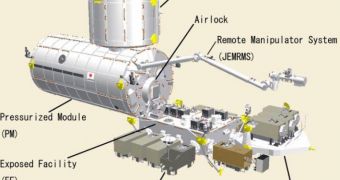The Japanese Aerospace Exploration Agency (JAXA) had reasons to celebrate yesterday. Everything that went on on the International Space Station was centered around the newly completed Kibo module. With a price tag of more than $1 billion, the most complex laboratory on the ISS used its robotic arm on Thursday to move experiments from a stowage platform to the newly installed, porch-like Exposed Facility, at the outer end of the module. The day also marked the first time the ten-meter (33-foot) -long arm on the Japanese segment was used for actually handling loads on the new facilities.
The JEM-EF was added to the ISS this week, after astronauts on the space shuttle Endeavor finally managed to take off and catch up with the station. Initially, as Flight Engineer Koichi Wakata attempted to use the robotic arm, it proved to have some problems with the grapple mechanism, but all those issues were eventually fixed, and the machine worked flawlessly afterwards. Additionally, when movements were initiated, it swung around too fast, and Wakata took it off automatic mode, and placed it into the slower going manual mode.
Three important experiments were added to the Exposed Facility during Thursday's operations, a press release on NASA's website announces. The Monitor of All-sky X-ray Image (MAXI), Inter-orbit Communication System (ICS) and Space Environment Data Acquisition Equipment-Attached Payload (SEDA-AP) were all neatly put in their places. The ICS is very important for Kibo, because it offers a direct voice/image channel to the Tsukuba Space Center Mission Control, in Japan, via the nation's own satellite system.
Other astronauts in the 13-member crew currently aboard the orbital lab spent their days arranging and preparing tools, spacesuits and other equipment, which will be used during today's spacewalk. Endeavor Mission Specialists Chris Cassidy and Tom Marshburn are scheduled to go outside the station and replace all of the four batteries in the P6 truss rod segment. The other two batteries were changed yesterday, but Cassidy and David Wolf had to cut their mission short on account of a slightly elevated level of carbon dioxide in Cassidy's suit. Today's spacewalk will require the two specialists to replace four batteries, instead of two, which means that the EVA will stretch for about seven and a half hours.

 14 DAY TRIAL //
14 DAY TRIAL //